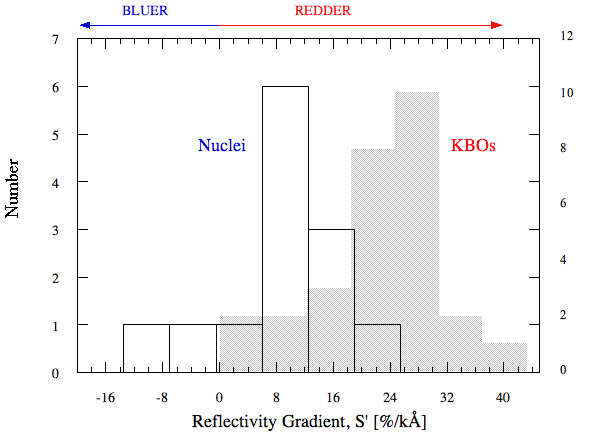 (Click on the figure to enlarge it)
(Click on the figure to enlarge it)
|
The Ultrared Matter is Missing
David
Jewitt
Astronomical Journal, 2002, 123, 1039-1049.
|
|---|
In a Nutshell
The Kuiper belt is widely thought to be the source of the short-period
(specifically "Jupiter Family") comets. If so, one might expect the
physical properties of the latter to be like those of the former. To
test this expectation, I measured and compared the optical colors of a
set of cometary nuclei with the colors of KBOs
measured in the same way. The result, shown in the Figure below, is that
the two types of object have color distributions which are NOT the
same. The most important difference is that the "ultrared matter" that
is a distinctive component of the surface materials on many KBOs is
rare or absent on the surfaces of cometary nuclei, hence the title
to this paper.
 (Click on the figure to enlarge it)
(Click on the figure to enlarge it)
How Could This Be?
There are several possibilities. The most likely is that the observed
cometary nuclei are highly modified with respect to their Kuiper belt
counterparts. There is more than enough time for various modification
processes to occur in the 10 Myr journey from Kuiper Belt to comet, and
there are several possible processes capable of causing the color
change. The one I prefer is simple resurfacing of the nucleus, by
suborbital debris launched from the nuclei once they begin to sublimate
inside the orbit of Jupiter. The timescale for this process is
miniscule, and we know that it happens. Essentially, the nuclei are
covered in a cloak of fall-back debris that obliterates the
more primordial surface.
So What?
This observations shows that the cometary nuclei cannot be considered
as pristine samples of the Kuiper Belt. They are modified samples,
perhaps greatly modified by thermal and physical effects.
Spacecraft launched to study the nuclei as carriers of primitive
matter will in fact be measuring objects that are quite different from
in their source regions.
The paper itself as a PDF file.
Last updated April 2003